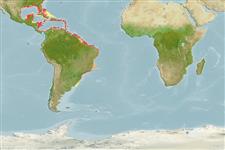>
Carangaria/misc (Various families in series Carangaria) >
Centropomidae (Snooks)
Etymology: Centropomus: Greek, kentron = sting + Greek, poma, -atos = cover, operculum (Ref. 45335).
More on author: Bloch.
Environment: milieu / climate zone / depth range / distribution range
Écologie
marin; eau douce; saumâtre récifal; amphidrome (Ref. 51243); profondeur ? - 22 m (Ref. 26912). Tropical; 25°C - 31°C (Ref. 36880); 33°N - 35°S, 98°W - 33°W
Western Atlantic: southern Florida (USA), southeastern coast of the Gulf of Mexico, most of the Antilles and Caribbean coast of Central and South America extending southward to Rio de Janeiro, Brazil; also North Carolina and Texas, USA (Ref. 7251).
Length at first maturity / Taille / Poids / Âge
Maturity: Lm ?, range 42 - ? cm
Max length : 140 cm TL mâle / non sexé; (Ref. 9710); common length : 50.0 cm TL mâle / non sexé; (Ref. 3713); poids max. publié: 24.3 kg (Ref. 4699); âge max. reporté: 7 années (Ref. 12193)
Épines dorsales (Total): 8 - 9; Rayons mous dorsaux (Total): 10; Épines anales 3; Rayons mous anaux: 6. 67- to 72 pored scales on lateral line to base of caudal fin (Ref. 26938). Black lateral line (Ref. 13442).
Adults inhabit coastal waters, estuaries and lagoons, penetrating into freshwater; usually at depths less than 20 m (Ref. 3713). Feed on fishes (Gobiidae, Gerreidae, Engraulidae) and crustaceans (shrimps and crabs) (Ref. 35237). Mature individuals congregate at mouths of passes and rivers during the spawning season, May through September (Ref. 3713). Seasonal movements into freshwater occur but poorly understood (Ref. 3713). Marketed fresh (Ref. 5712). Valued game fish and an excellent food fish (Ref. 26938). The world record for hook and line is a 53-lb., 10 ounce fish caught at Parismina Ranch, Costa Rica (Ref. 13442).
Also Ref. 103751.
Robins, C.R. and G.C. Ray, 1986. A field guide to Atlantic coast fishes of North America. Houghton Mifflin Company, Boston, U.S.A. 354 p. (Ref. 7251)
Statut dans la liste rouge de l'IUCN (Ref. 130435)
Menace pour l'homme
Harmless
Utilisations par l'homme
Pêcheries: commercial; Aquaculture: commercial; pêche sportive: oui
Plus d'informations
RéférencesAquacultureProfil d'aquacultureSouchesGénétiqueElectrophoresesHéritabilitéPathologiesTraitementNutrientsMass conversion
CollaborateursImagesStamps, Coins Misc.SonsCiguateraVitesseType de nageSurface branchialeOtolithesCerveauxVision
Outils
Articles particuliers
Télécharger en XML
Sources Internet
Estimates based on models
Preferred temperature (Ref.
123201): 23.5 - 28.1, mean 27.3 °C (based on 864 cells).
Phylogenetic diversity index (Ref.
82804): PD
50 = 0.5005 [Uniqueness, from 0.5 = low to 2.0 = high].
Bayesian length-weight: a=0.00741 (0.00587 - 0.00936), b=3.02 (2.97 - 3.07), in cm total length, based on LWR estimates for this species (Ref.
93245).
Niveau trophique (Ref.
69278): 4.2 ±0.6 se; based on diet studies.
Résilience (Ref.
120179): Milieu, temps minimum de doublement de population : 1,4 à 4,4 années (K=0.3-0.49; tm=4; tmax=7; Fec=3 million).
Prior r = 0.87, 95% CL = 0.58 - 1.31, Based on 2 stock assessments.
Fishing Vulnerability (Ref.
59153): Moderate to high vulnerability (46 of 100).
Climate Vulnerability (Ref.
125649): Very high vulnerability (86 of 100).
Nutrients (Ref.
124155): Calcium = 25.4 [15.4, 38.4] mg/100g; Iron = 0.523 [0.319, 0.792] mg/100g; Protein = 20.3 [17.9, 22.5] %; Omega3 = 0.139 [0.065, 0.297] g/100g; Selenium = 34.5 [19.7, 59.5] μg/100g; VitaminA = 52.2 [18.4, 155.2] μg/100g; Zinc = 0.769 [0.560, 1.077] mg/100g (wet weight);
